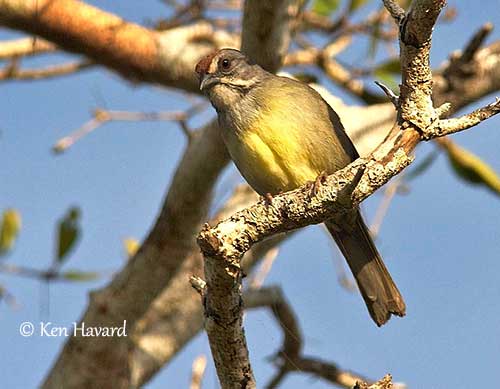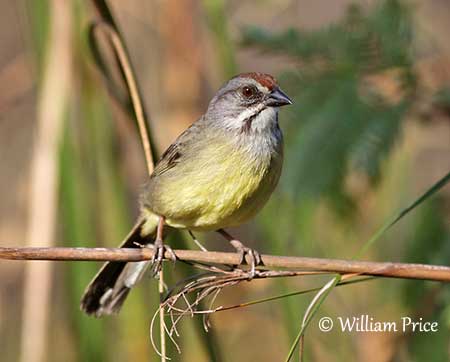
Fr: Bruant de Zapata
Ang: Zapata Sparrow – Cuban Sparrow
All: Zapataammer
Esp: Chingolo de la Ciénaga
Ita: Passero di Zapata
Nd: Zapatagors
Sd: Zapatasparv
Photographers:
Ken Havard
My Bird Gallery & Flickr gallery 1 & Flickr gallery 2
William Price
PBase-tereksandpiper & Flickr William Price
Text by Nicole Bouglouan
Sources :
HANDBOOK OF THE BIRDS OF THE WORLD Vol 16 by Josep del Hoyo- Andrew Elliot-David Christie – Lynx Edicions – ISBN: 9788496553781
BIRDS OF THE WEST INDIES – by Herbert Raffaele, Kristin Williams et Tracy Pedersen – Helm – ISBN: 9780713649055
L’ENCYCLOPEDIE MONDIALE DES OISEAUX - Dr Christopher M. Perrins - BORDAS - ISBN: 2040185607
Neotropical Birds – Cornell Lab of Ornithology
Arthur Grosset's Birds (Arthur Grosset)
Wikipedia, the free encyclopaedia
Zapata Sparrow
Torreornis inexpectata
Passeriformes Order – Passerellidae Family
INTRODUCTION:
The Zapata Sparrow is confined and endemic to Cuba. It lives on the island of Cuba, and especially in the grasslands of the Zapata Swamp for the nominate race. It is the only member of the genus Torreornis, close to Aimophila by general structure and skeletal data, but the plumage is very different. Three subspecies are recognized on Cuba where they occur in a wide range of habitats.
This species is threatened by degradation of its habitat through drainage of wet areas and agriculture expansion involving pollution, tourism industry and increasing urbanization.
The Zapata Sparrow is also known as Cuban Sparrow. It was discovered in March 1927 in the Zapata Swamp by the Spanish zoologist Fermín Zanón Cervera.

SUBSPECIES AND RANGE:
The Zapata Sparrow has three recognized subspecies showing differences in plumage and ecology.
T.i. inexpectata (described above) occurs in Zapata Swam in W Cuba.
T.i. varonai occurs in Cayo Coco and Cayo Romano in Camagüey Province off NC Cuba. This race is similar to nominate, but the crown is darker rufous and the face pattern is bolder.
T.i. sigmani occurs in the coastal areas of Guantanamo Province in SE Cuba. This race is smaller with smaller bill, paler plumage with duller rufous crown, less greyish-olive on breast and flanks, and paler yellow belly. The upperparts are less streaked.
HABITAT:
The Zapata Sparrow of nominate race “inexpectata” frequents country with large sedges (sawgrass) Cladium jamaicense of family Cyperaceae and with scattered bushes.
The race “varonai” is widespread on Cayo Coco, from the semi-deciduous, open wooded areas to the swampy locations.
The race “sigmani” lives among very dry vegetation in the most arid part of the island with coastal thorn-scrub, forest and cactus stands.
CALLS AND SONGS: SOUNDS BY XENO-CANTO
The Zapata Sparrow has four distinct calls, with two calls fairly similar only heard during the breeding season.
The foraging pair communicates through short, penetrating trill repeated at intervals, a high-pitched “tziii-tzziii-tzziii…”
When the bird hides among vegetation, it utters a “tic-tic-tic…”
During the breeding season, the Zapata Sparrow gives similar courtship and territorial calls. These sounds are long and high-pitched, a series of somewhat raspy notes ending in a deeper note “tzi,tzi,tziii,tzzii,zu,zu,zu…”. The pair duets during this period, producing a chatter-duet including short notes given by both mates.
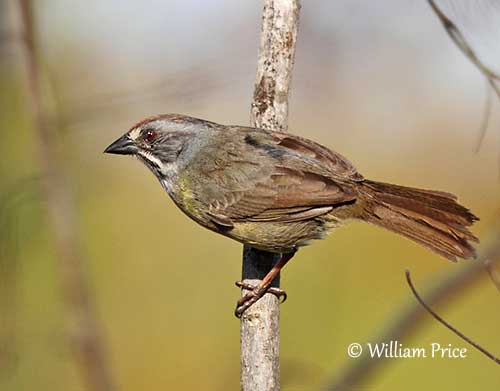
BEHAVIOUR IN THE WILD:
The Zapata Sparrow’s diet varies by subspecies, season and habitat types.
The nominate race “inexpectata” feeds on fruits and seeds of plants during the dry season, and mostly on insects and eggs of snails Pomacea paludosa during the wet season.
The subspecies “varonai” on Cayo Coco feeds mainly on insects including Coleopteran and Tenebrionidae, but it also takes seeds and fruits on the ground.
The race “sigmani” feeds primarily on seeds of coastal plants Tournefortia gnaphalodes, and cactus fruits.
The diet includes small lizards during the wet season.
The Zapata Sparrow forages on the ground by hoping and scratching in the leaf litter with both feet. They often feed in small parties of 2-3 birds, and occasionally in larger flocks of 10-12 individuals.
The pair appears to defend territories all year round, and the male stays close to the female during the egg-laying period, probably as “mate-guarding”. They are monogamous.
The courtship displays are poorly known, but the birds probably perform flight displays and adopt postures that enhance the chestnut crown and the head pattern. The pair duets during the breeding season. Both mates fly to a branch and perch at about 7-30 centimetres of each other. They sing together while wavering slowly their wings.
The Zapata Sparrow is resident on Cuba. It has short, rounded wings and is known as a weak flier. Its flight is laboured with rapid bursts of wingbeats. It usually flies over short distances, usually up to 100 metres.
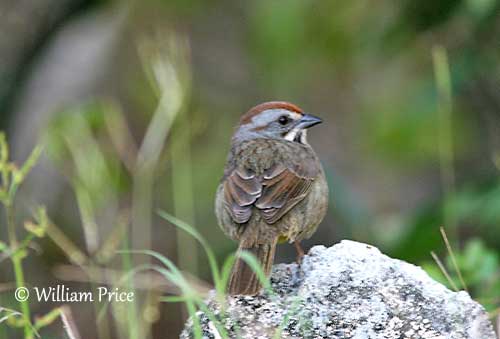
REPRODUCTION OF THIS SPECIES:
The breeding season takes place between March and June, but this species is also reported to nest in August.
The Zapata Sparrow of nominate race “inexpectata” is the only studied subspecies while breeding in Zapata Swamp. The cup-shaped nest is made with woven leaves, stems and grasses, and the inner cup is lined with softer vegetation. It is usually placed in the uppermost part of a grass tussock, less than one metre from the ground. It is often hidden in a sawgrass Cladium jamaicense. This structure is built by both adults.
The female lays 1-2 pale green eggs with dark spots. No more information. However, usually, the birds of the family Emberizidae incubate during 10-14 days, and the young fledge about 10-15 days after hatching.
PROTECTION / THREATS / STATUS:
The Zapata Sparrow is confined to Cuba and has restricted range. It is threatened by habitat loss through drainage and dry-season burning. The race “varonai” is threatened by tourism industry, whereas the race “sigmani” suffers from burning of habitat, grass invasion and sheep-rearing.
None of the three races is officially protected, but each has been found in protected areas. The population is suspected to be declining due to habitat loss. The global population is estimated to number 1,000/2,499 individuals.
The Zapata Sparrow is currently listed as Endangered.
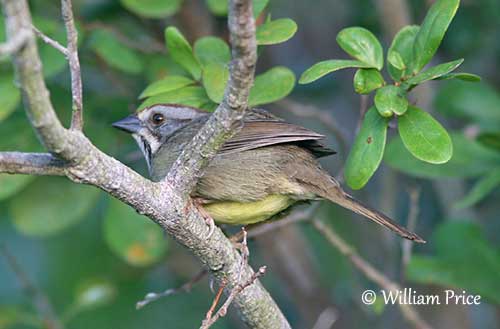
DESCRIPTION OF THE BIRD:
Biometrics:
Length: 16-17 cm
Weight: 20-30 g
The Zapata Sparrow adult male of nominate race is a plump sparrow with olive-grey upperparts. Mantle to upper back and scapulars are streaked brown. The tail is dark brown with narrow grey-buff edges to rectrices. The upperwing is brownish with warm brown and rusty edges to coverts, forming a warm brown panel when the wings are closed. Wings are short and rounded.
On the underparts, chin and throat are white. The upper breast is greyish with olive-yellow sides. Lower breast and belly are dull yellow, but the flanks are darker, mostly olive-yellow.
On the large head, the crown is chestnut with weak greyish median stripe, and the nape is grey. We can see a grey supercilium, paler in supraloral area, extending to the ear-coverts. The face is grey with narrow black moustachial stripe contrasting with broader white submoustachial stripe, bordered below by a black malar stripe. There is a narrow, brown eye stripe.
The pointed bill is black, sometimes with blue-grey tinge on lower mandible. The eyes are dark chestnut. Legs and feet are flesh-coloured.
Male and female are similar.
The juvenile resembles adult with duller coloration overall.
